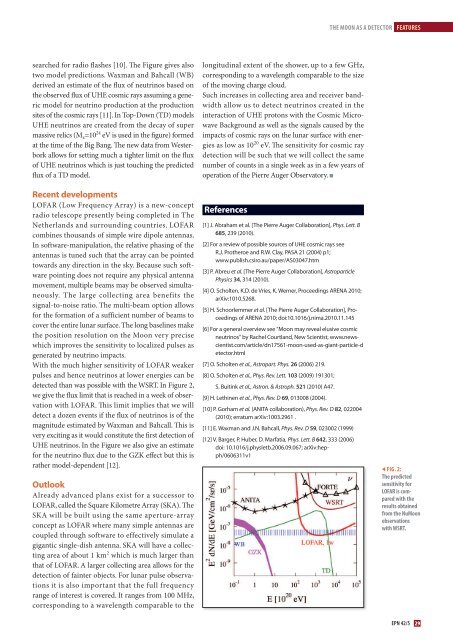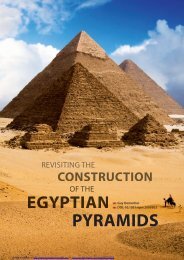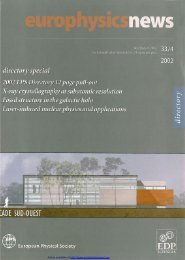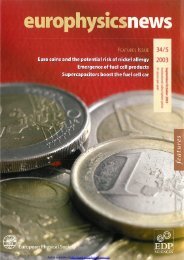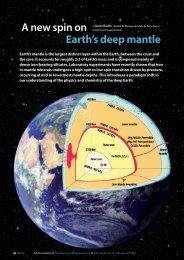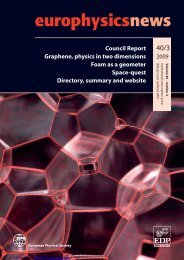PDF (11.37 MB) - Europhysics News
PDF (11.37 MB) - Europhysics News
PDF (11.37 MB) - Europhysics News
You also want an ePaper? Increase the reach of your titles
YUMPU automatically turns print PDFs into web optimized ePapers that Google loves.
searched for radio flashes [10]. �e Figure gives also<br />
two model predictions. Waxman and Bahcall (WB)<br />
derived an estimate of the flux of neutrinos based on<br />
the observed flux of UHE cosmic rays assuming a generic<br />
model for neutrino production at the production<br />
sites of the cosmic rays [11]. In Top-Down (TD) models<br />
UHE neutrinos are created from the decay of super<br />
massive relics (M x=10 24 eV is used in the figure) formed<br />
at the time of the Big Bang. �e new data from Westerbork<br />
allows for setting much a tighter limit on the flux<br />
of UHE neutrinos which is just touching the predicted<br />
flux of a TD model.<br />
Recent developments<br />
LOFAR (Low Frequency Array) is a new-concept<br />
radio telescope presently being completed in The<br />
Netherlands and surrounding countries. LOFAR<br />
combines thousands of simple wire dipole antennas.<br />
In software-manipulation, the relative phasing of the<br />
antennas is tuned such that the array can be pointed<br />
towards any direction in the sky. Because such software<br />
pointing does not require any physical antenna<br />
movement, multiple beams may be observed simultaneously.<br />
The large collecting area benefits the<br />
signal-to-noise ratio. The multi-beam option allows<br />
for the formation of a sufficient number of beams to<br />
cover the entire lunar surface. The long baselines make<br />
the position resolution on the Moon very precise<br />
which improves the sensitivity to localized pulses as<br />
generated by neutrino impacts.<br />
With the much higher sensitivity of LOFAR weaker<br />
pulses and hence neutrinos at lower energies can be<br />
detected than was possible with the WSRT. In Figure 2,<br />
we give the flux limit that is reached in a week of observation<br />
with LOFAR. �is limit implies that we will<br />
detect a dozen events if the flux of neutrinos is of the<br />
magnitude estimated by Waxman and Bahcall. �is is<br />
very exciting as it would constitute the first detection of<br />
UHE neutrinos. In the Figure we also give an estimate<br />
for the neutrino flux due to the GZK effect but this is<br />
rather model-dependent [12].<br />
Outlook<br />
Already advanced plans exist for a successor to<br />
LOFAR, called the Square Kilometre Array (SKA). The<br />
SKA will be built using the same aperture-array<br />
concept as LOFAR where many simple antennas are<br />
coupled through software to effectively simulate a<br />
gigantic single-dish antenna. SKA will have a collecting<br />
area of about 1 km 2 which is much larger than<br />
that of LOFAR. A larger collecting area allows for the<br />
detection of fainter objects. For lunar pulse observations<br />
it is also important that the full frequency<br />
range of interest is covered. It ranges from 100 MHz,<br />
corresponding to a wavelength comparable to the<br />
longitudinal extent of the shower, up to a few GHz,<br />
corresponding to a wavelength comparable to the size<br />
of the moving charge cloud.<br />
Such increases in collecting area and receiver bandwidth<br />
allow us to detect neutrinos created in the<br />
interaction of UHE protons with the Cosmic Microwave<br />
Background as well as the signals caused by the<br />
impacts of cosmic rays on the lunar surface with energies<br />
as low as 10 20 eV. �e sensitivity for cosmic ray<br />
detection will be such that we will collect the same<br />
number of counts in a single week as in a few years of<br />
operation of the Pierre Auger Observatory. ■<br />
References<br />
[1] J. Abraham et al. [The Pierre Auger Collaboration], Phys. Lett. B<br />
685, 239 (2010).<br />
[2] For a review of possible sources of UHE cosmic rays see<br />
R.J. Protheroe and R.W. Clay, PASA 21 (2004) p1;<br />
www.publish.csiro.au/paper/AS03047.htm<br />
[3] P. Abreu et al. [The Pierre Auger Collaboration], Astroparticle<br />
Physics 34, 314 (2010).<br />
[4] O. Scholten, K.D. de Vries, K. Werner, Proceedings ARENA 2010;<br />
arXiv:1010.5268.<br />
[5] H. Schoorlemmer et al. [The Pierre Auger Collaboration], Proceedings<br />
of ARENA 2010; doi:10.1016/j.nima.2010.11.145<br />
[6] For a general overview see "Moon may reveal elusive cosmic<br />
neutrinos" by Rachel Courtland, New Scientist, www.newscientist.com/article/dn17561-moon-used-as-giant-particle-d<br />
etector.html<br />
[7] O. Scholten et al., Astropart. Phys. 26 (2006) 219.<br />
[8] O. Scholten et al., Phys. Rev. Lett. 103 (2009) 191301;<br />
S. Buitink et al., Astron. & Astroph. 521 (2010) A47.<br />
[9] H. Lethinen et al., Phys. Rev. D 69, 013008 (2004).<br />
[10] P. Gorham et al. (ANITA collaboration), Phys. Rev. D 82, 022004<br />
(2010); erratum arXiv:1003.2961 .<br />
[11] E. Waxman and J.N. Bahcall, Phys. Rev. D 59, 023002 (1999)<br />
[12] V. Barger, P. Huber, D. Marfatia, Phys. Lett. B 642, 333 (2006)<br />
doi: 10.1016/j.physletb.2006.09.067; arXiv:hepph/0606311v1<br />
THe moon aS a deTeCTor feaTureS<br />
� fig. 2:<br />
The predicted<br />
sensitivity for<br />
lofar is compared<br />
with the<br />
results obtained<br />
from the numoon<br />
observations<br />
with wSrT.<br />
EPN 42/5 29


